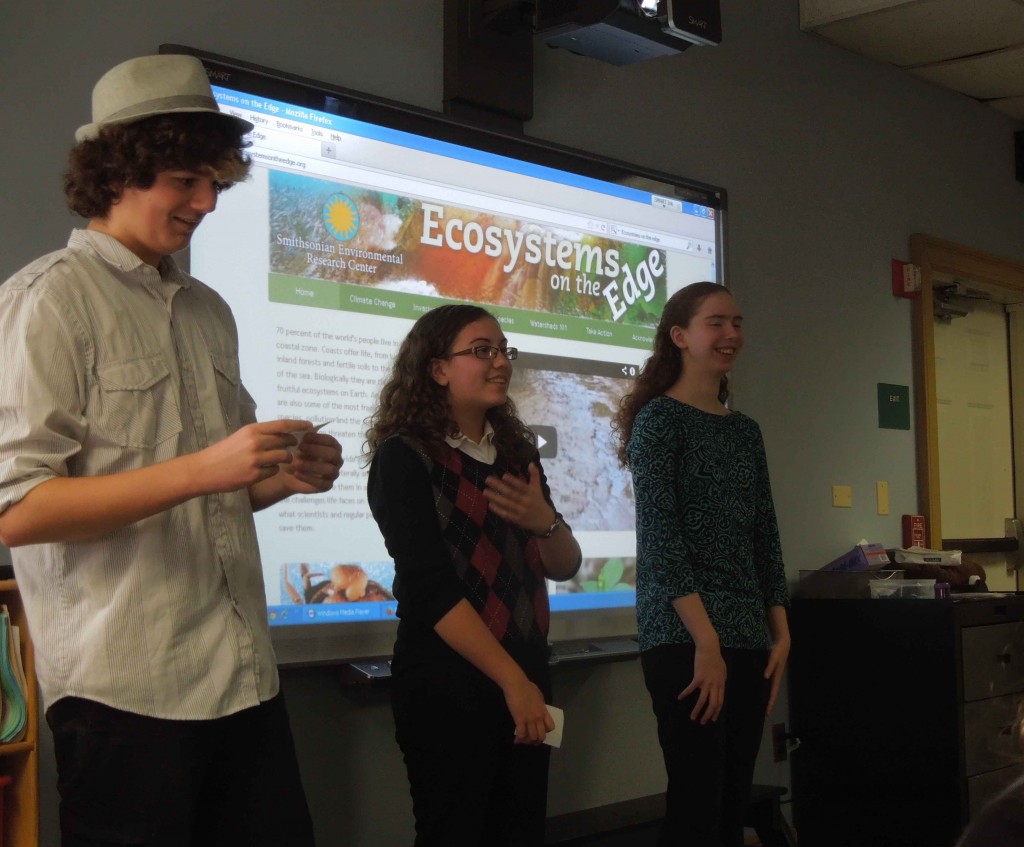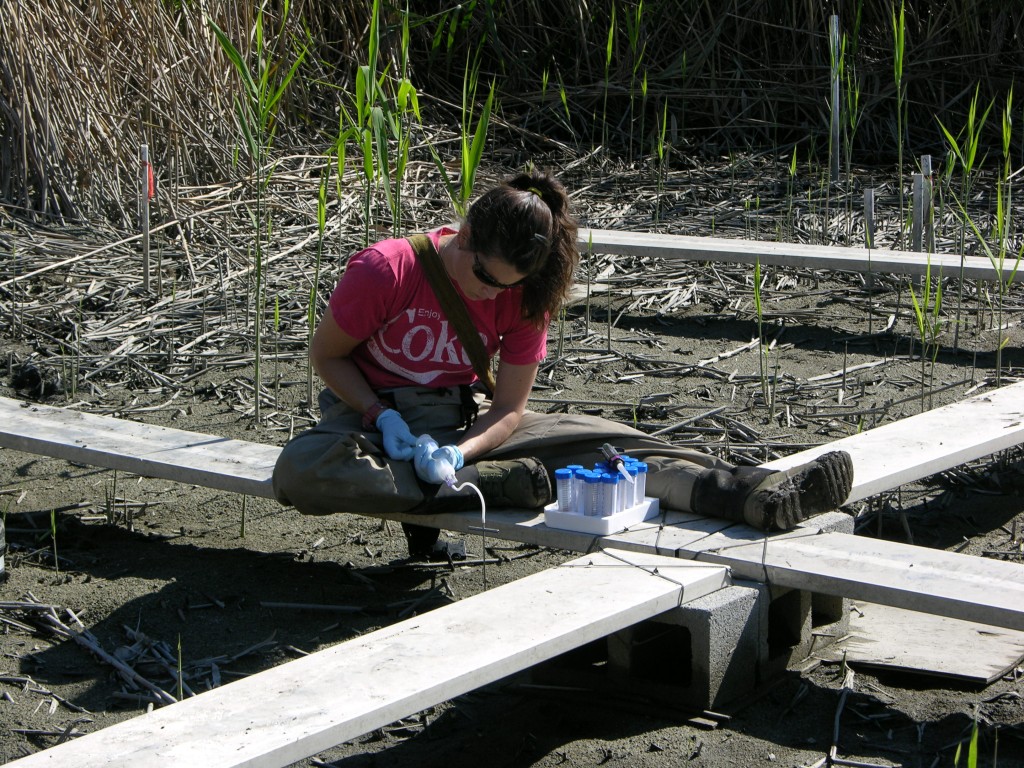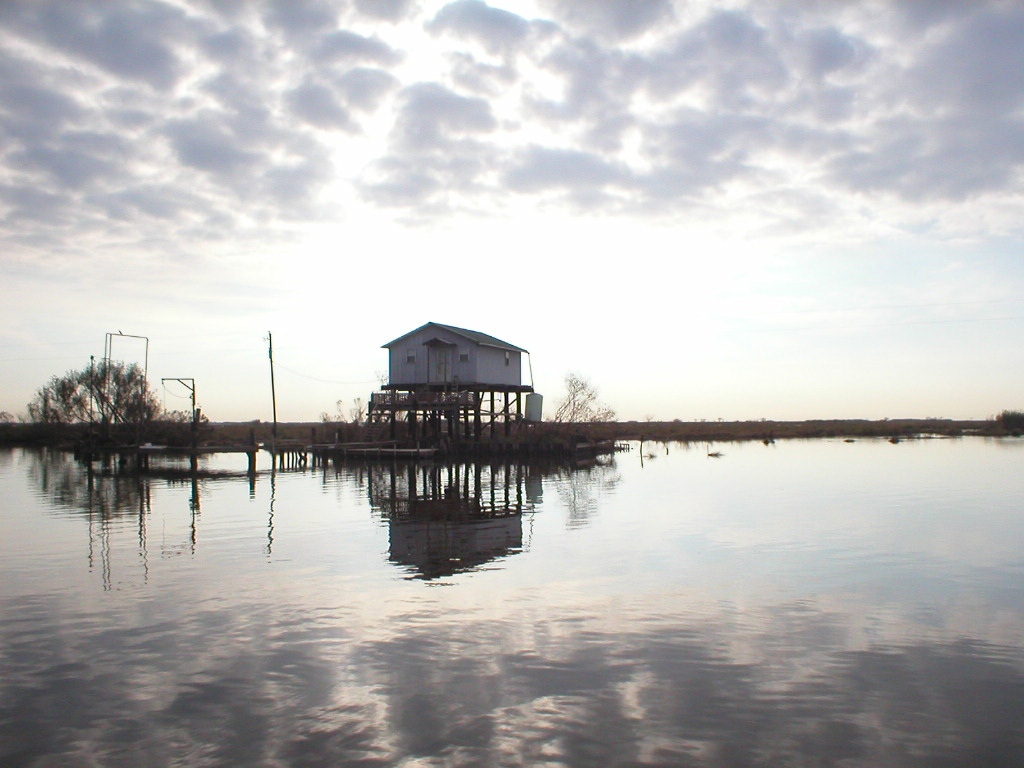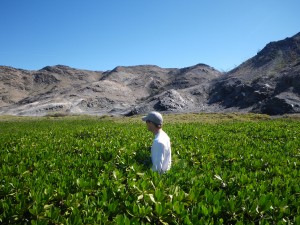by Kristen Minogue
Eleven-year-old Lucy Paskoff knows something about the hazards of filming wildlife. She and fellow home-school student McKenna Austin-Ward spent weeks documenting one of Chesapeake Bay’s most destructive pests: the mute swan.

by Kristen Minogue
Eleven-year-old Lucy Paskoff knows something about the hazards of filming wildlife. She and fellow home-school student McKenna Austin-Ward spent weeks documenting one of Chesapeake Bay’s most destructive pests: the mute swan.
by Karen McDonald

From left: SERC home-school students Joe Giardina, Molly Enriquez and Anne Marie Nolan at the student documentary film screening. (SERC)
It began with a video series called Ecosystems on the Edge. Home-school students ages 11 to 16 came to the Smithsonian Environmental Research Center every two weeks, from September 2013 to January 2014, to create short science documentaries. Their abilities ranged from knowing how to shoot film to knowing how to turn on a computer, but full-scale video production was new to all of them. The Ecosystems series–short videos of SERC scientists working to save the coast–provided a springboard of ideas. The rest of the creative process was up to the students.
They broke into teams, ranging from one student to three. Instructor Karen McDonald walked them through the documentary-making process. Each team had to draft a proposal, draw a story board, create a shot list and script, interview SERC scientists on camera, film “B” roll (extra film) and find narrators, or read the narration themselves. Then came post-production, when the students spent weeks learning to use editing software.
By January, four teams overcame the environmental snags and technical difficulties and produced their own documentary shorts. From invasive earthworms to mute swans, here are their films:
Invisible Invasion: Joe Giardina, Molly Enriquez, Anne Marie Nolan. Using ideas from the video Earthworm Invaders, this group focused on the silent and invisible invasion of earthworms in forests and the effects of invasive worms on forest ecosystems.
Beauty and Beast: McKenna-Austin Ward, Lucy Paskoff, Max Gwinn. This documentary was inspired by the video Alien Invader, which looked at invasive barnacles in the Chesapeake Bay. For their video the students chose the invasive mute swan, and compared people’s perception of the bird as beautiful to its beastly effect on the flora and fauna of the Bay.
Behind-the-Scenes: Filming Mute Swans in the Wild >>
Invertebrates as Bioindicators: Xanthia Strohl. Inspired by the video Stream Health, Xanthia explored the idea of using blue crabs and crayfish as indicators of water quality and health in the Bay, and suggested ideas for helping reduce runoff.
Blue Crabs-The Soul of the Chesapeake Bay: Abbie and Katie Cannon. This team of sisters was moved by the Blue Crabs: Top Predator in Peril film. Their documentary is based on the plight of the blue crab in the Bay, and factors affecting its population and success.
by Karen McDonald
Can’t get to water to fish up a blue crab? Want to teach about blue crabs and Smithsonian research but can’t make it to SERC or the Chesapeake Bay? Landlocked, but you want students to measure a crab’s carapace and learn about its life cycle? SERC has the answer: a virtual blue crab.
The blue crab is just part of the new Smithsonian X3D—a revolutionary way for visitors to interact with Smithsonian collections and research. In November 2013 the Smithsonian launched the Smithsonian X3D (beta) program, which allows visitors to flip, rotate and zoom in on digitized 3D images of objects from across the Institution. Right now they can explore more than 20 objects, including Amelia Earhart’s flight suit, the Wright brothers’ plane and a life mask of Lincoln.
Wood frogs (Lithobates sylvaticus) freeze solid over winter and come back to life in spring
by Karen McDonald
Here in North America there are a wide variety of toads and frogs, but perhaps none are so unusual as the wood frog. These frogs are found in Eastern North America, Canada, and up into Alaska. On a warm spring night you might hear them singing(click here for sound clip) near bogs, vernal pools or upland forests, but something remarkable happens to them this time of year in the winter: They freeze solid. Now freezing solid isn’t remarkable by itself, but what is remarkable is that the frogs will literally come back to life in the spring, after having no heartbeat or brain activity (they don’t even breathe) for up to eight weeks! This baffles and amazes scientists, who are actively studying them even now.
by Kristen Minogue and Heather Dewar
As mangrove trees lose ground to deforestation and urban sprawl, one development seems to be giving them a boost: climate change. Fewer winter cold snaps have empowered them to conquer new territory around their northern Florida boundary, according to a study of 28 years of satellite data from the Smithsonian Environmental Research Center and the University of Maryland.
An estimated 35 percent of the world’s mangroves have been destroyed since 1980, according to previous research, outstripping tropical rainforests and coral reefs. They are also some of the planet’s most valuable ecosystems. Mangroves protect coastal cities from floods and hurricanes. Their above-ground roots shelter many commercially valuable fisheries, including blue crabs, shrimp and lobsters. And they are phenomenal at burying carbon. The soils of coastal ecosystems like mangroves can store carbon at a rate 50 times higher than tropical rainforests. Scientists have estimated their total ecosystem services value more than $1.6 trillion a year—making the expansion a possible blessing.
“Some people may say this is a good thing, because of the tremendous threats that mangroves face,” said the study’s lead author, Kyle Cavanaugh, a postdoctoral research fellow at the Smithsonian Environmental Research Center in Edgewater, Md. “But this is not taking place in a vacuum. The mangroves are replacing salt marshes, which have important ecosystem functions and food webs of their own.”
How an invasive marsh plant could leave many fishes and invertebrates homeless, hungry and vulnerable to predators
by Heather Soulen, SERC marine ecology lab technicianIt’s no surprise that invasive species can dramatically alter an ecosystem. Often, invasive species outcompete native species and disturb ecosystems that have not evolved to handle the new intruder(s). One such invader is the introduced common reed (Phragmites australis australis). Introduced Phragmites alters native plant communities that native animals use. Over the past several decades, native marshes containing plants such as marsh elder, saltmeadow hay, black needlerush, sea lavender, cordgrasses, threesquares and bulrushes have fallen to introduced Phragmites in the Chesapeake Bay and throughout the Atlantic coast, turning once diverse marshes into a thick monoculture forest.
The Great Marsh Surface Uprising
Click to continue »
by Kristen Minogue

Ally Bullock, a technician in SERC’s mercury lab, draws pore water samples from a mid-Atlantic Superfund site. (SERC)
There are places in the U.S. so polluted, eating fish or crabs from their waters isn’t just unhealthy—it can be illegal. The Environmental Protection Agency calls sites like that “Superfund sites,” a label for abandoned or neglected sites that became dumping grounds for hazardous waste. Some of the highest levels of mercury contamination in the U.S. exist in Superfund sites. Cynthia Gilmour knows this first-hand. As a microbial ecologist at the Smithsonian Environmental Research Center, she has worked in several. But short of digging up the polluted sediments and dumping them elsewhere (an expensive and ecologically risky proposition), not many methods exist to get rid of the problem.
“If we use the traditional technologies of removing that and putting it in a landfill, we don’t have a wetland anymore,” says Upal Ghosh, an environmental engineer from the University of Maryland, Baltimore County, who works with Gilmour.
This fall, Gilmour and Ghosh explored a new technique: using charcoal to trap it in the soil.
by Brooke Weigel

Brooke Weigel displays a recently-caught blue catfish in SERC’s Fish & Invertebrate Lab. (Katie Sinclair)
Have you ever wondered how far a fish can swim in one day? Acoustic telemetry enables researchers to track the movement, migration and behavior of fish. Beginning this past summer, the Fish and Invertebrate Ecology Lab started using acoustic telemetry to study the movement patterns of invasive blue catfish in the Patuxent River, a tributary of Chesapeake Bay.
Native to the Mississippi River, blue catfish were introduced for sport fishing in Virginia in the 1970s. Since introduction, these non-native top predators have expanded their range into many of Maryland’s tributaries. Their voracious appetites affect native fish populations and disrupt the food webs in these rivers. Blue catfish are the largest and most migratory species of catfish in North America. In their native waters, blue catfish have been known to migrate up to 200 km between different habitats used for spawning, feeding and overwintering. But little is known about their movement patterns within the Chesapeake Bay watershed, which is our motivation for using acoustic telemetry to track the movements of individual blue catfish.
Similar to radio tracking used to locate animals over vast distances, acoustic telemetry is a two-part system: Each fish has a transmitting tag, which emits a unique series of underwater sounds or “pings” at a random interval every one to three minutes. Stationary receivers then detect and decode these pings whenever a fish swims within range of the receiver. These detection data are converted to digital data and stored until researchers download the data onto a computer.
Interning at SERC for the past six months has given me the opportunity to be involved in every step of the process—some of which were messier than others.
by Kristen Minogue

Fishing camp along Falgout Canal Bayou, La., where marsh has submerged into open water and remains mostly on canal leaves. (Matt Kirwin/VIMS)
Left to themselves, coastal wetlands can adapt to sea-level rise. But humans could be sabotaging some of their best defenses, according to a review paper from the Smithsonian Environmental Research Center and the Virginia Institute of Marine Science to be published Thursday, Dec. 5, in Nature.
The threat of disappearing coastlines has alerted many to the dangers of climate change. Wetlands in particular—with their ability to buffer coastal cities from floods and storms, and filter out pollution—offer protections that could be lost in the future. But, say co-authors Matt Kirwan and Patrick Megonigal, higher waters are not the key factor in wetland demise. Thanks to an intricate system of ecosystem feedbacks, wetlands are remarkably good at building up soil to outpace sea-level rise. But this ability has limits. The real issue, the scientists say, is that human structures such as dams and seawalls are disrupting the natural mechanisms that have allowed coastal marshes to survive rising seas since at least the end of the last ice age.
by Cora Ann Johnston
Get ready

Researcher Mike Lehmann makes his way through dwarf-form mangroves in the Gulf of California. (C. Johnston)
As you approach stands of mangroves in Florida, you’re likely to notice a few things. They form expansive forests along protected seashore (usually in lagoons and estuaries) that often grow thick and tall overhead, providing welcome shade where the three species (black, white and red) intermingle. In the cool of their shade, they are clearly teeming with life; the constant pop of snapping shrimp ricochets around their oyster- and barnacle-encrusted roots while crabs and insects scurry along their branches.
These mangroves are different. There are no scurrying crabs or snapping shrimp or prominent rocks of oysters. Most of the insects have gone inside; their only traces are burrows and cocoons made in the safety of stems and rolled leaves. The blinding sun and gusty wind make it starkly obvious that the shady, protective canopy is only waist-high. The cactus on the rocky slope in the background gives it away: These mangroves are in Baja California, Mexico.